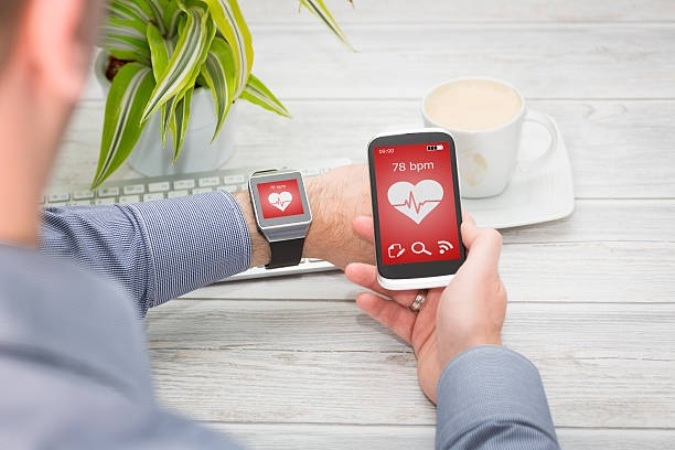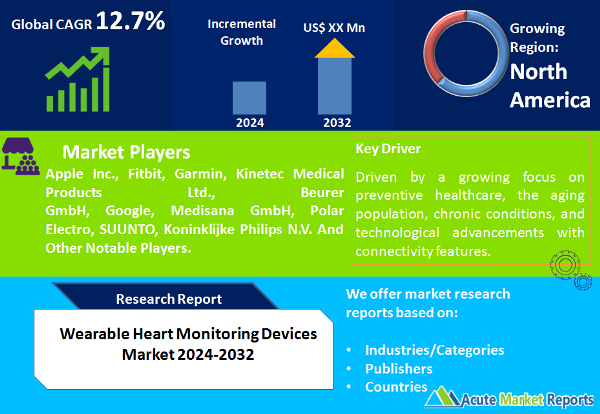
The wearable heart monitoring devices market is at the forefront of healthcare technology, offering innovative solutions for heart monitoring and overall well-being. The wearable heart monitoring devices market is expected to grow at a CAGR of 12.7% during the forecast period of 2025 to 2033, driven by a growing focus on preventive healthcare, the aging population, chronic conditions, and technological advancements with connectivity features. However, data security and privacy concerns pose a significant restraint. Market segmentation by product and application reveals varying trends, with different segments leading in revenue and CAGR. Geographic trends highlight regional variations, with North America and the Asia-Pacific region playing pivotal roles.

Growing Focus on Preventive Healthcare
One of the primary drivers propelling the wearable heart monitoring devices market is the growing focus on preventive healthcare. In 2024, there was an increasing awareness among individuals about the importance of monitoring their heart health regularly. Wearable heart monitoring devices, such as smartwatches and pulse oximeters, have gained popularity as they allow users to track their heart rate, blood pressure, and other vital signs. As evidence, health-conscious consumers have been adopting these devices as part of their daily routines to monitor their heart health and take preventive measures. The expected continuation of this trend is likely to drive the demand for wearable heart monitoring devices in the coming years.
Aging Population and Chronic Conditions
The aging population and the prevalence of chronic health conditions have been significant drivers of the wearable heart monitoring devices market. In 2024, the aging demographic and the increase in chronic conditions such as cardiovascular diseases, diabetes, and hypertension have highlighted the need for continuous heart monitoring. Wearable devices offer a non-invasive and convenient way to monitor vital signs, making them particularly valuable for older individuals and those with chronic health issues. As evidence, healthcare providers have incorporated wearable heart monitoring devices into their patient care strategies, contributing to the devices' adoption. The expected growth in the aging population and the burden of chronic conditions are set to boost the demand for these devices.
Technological Advancements and Connectivity
Technological advancements and the integration of connectivity features have been driving innovation in the wearable heart-monitoring devices market. In 2024, wearable devices evolved to offer more sophisticated features, including real-time data sharing, remote monitoring, and compatibility with smartphones and other devices. These technological enhancements provide users with more insights into their heart health and enable healthcare professionals to remotely monitor patients. As evidence, leading technology companies and healthcare providers have invested in wearable heart monitoring devices to offer cutting-edge solutions to their customers and patients. The anticipated further advancements in technology and connectivity are expected to drive the market's growth.
Data Security and Privacy Concerns
While the wearable heart monitoring devices market exhibits significant growth drivers, it is not without restraints. Data security and privacy concerns have emerged as critical issues in 2024. The collection and transmission of personal health data via wearable devices have raised questions about the security and protection of this sensitive information. As evidence, incidents of data breaches and privacy breaches related to wearable devices have led to increased scrutiny from regulatory bodies and users. These concerns may lead to more stringent data protection regulations and user hesitancy in adopting wearable heart monitoring devices.
Market Segmentation by Product: Smartwatches Dominate the Market
The wearable heart monitoring devices market is segmented by product into Chest Straps and patches, Pulse Oximeters, Blood Pressure Monitors, Smartwatches, and Others (such as Wrist Monitors and ECG Finger Sensors). In 2024, Smartwatches generated the highest revenue, while Pulse Oximeters exhibited the highest CAGR during the forecast period from 2025 to 2033. Smartwatches offer comprehensive health monitoring features, making them popular among consumers and contributing to their high revenue in 2024. Pulse Oximeters, with their critical role in measuring oxygen saturation levels, are expected to see significant growth in the forecast period due to their relevance in monitoring respiratory health.
Market Segmentation by Application: Healthcare Monitoring Dominates the Market
The market segmentation by application includes Healthcare Monitoring, Consumer Wellness, and Others (such as Research). In 2024, Healthcare Monitoring generated the highest revenue, while Consumer Wellness exhibited the highest CAGR during the forecast period from 2025 to 2033. Healthcare Monitoring applications, which include monitoring patients with heart conditions and chronic illnesses, contributed to the highest revenue in 2024. Consumer Wellness applications, focused on fitness and general well-being, are expected to exhibit substantial growth in the coming years as consumers prioritize their health.
North America Remains the Global Leader
Geographic trends in the wearable heart monitoring devices market highlight regional disparities in both revenue and CAGR. In 2024, North America led in revenue, driven by its advanced healthcare infrastructure and technology adoption. However, the Asia-Pacific region is projected to exhibit the highest CAGR from 2025 to 2033, reflecting the growing awareness of preventive healthcare and the increasing adoption of wearable devices. Europe, with its aging population, also plays a significant role in the market's dynamics.
Market Competition to Intensify during the Forecast Period
Competitive trends in the wearable heart monitoring devices market are characterized by top players and their key strategies. In 2024, companies such as Apple Inc., Fitbit, Garmin, Kinetec Medical Products Ltd., Beurer GmbH, Google, Medisana GmbH, Polar Electro, SUUNTO, and Koninklijke Philips N.V. were prominent in the industry, with substantial revenues from wearable heart monitoring device sales. These players are expected to continue their dominance in the forecast period from 2025 to 2033 through innovation, product diversification, and strategic partnerships. Their strategies focus on staying ahead in the competitive landscape and addressing the evolving needs of consumers and healthcare providers.
Historical & Forecast Period
This study report represents analysis of each segment from 2023 to 2033 considering 2024 as the base year. Compounded Annual Growth Rate (CAGR) for each of the respective segments estimated for the forecast period of 2025 to 2033.
The current report comprises of quantitative market estimations for each micro market for every geographical region and qualitative market analysis such as micro and macro environment analysis, market trends, competitive intelligence, segment analysis, porters five force model, top winning strategies, top investment markets, emerging trends and technological analysis, case studies, strategic conclusions and recommendations and other key market insights.
Research Methodology
The complete research study was conducted in three phases, namely: secondary research, primary research, and expert panel review. key data point that enables the estimation of Wearable Heart Monitoring Devices market are as follows:
Market forecast was performed through proprietary software that analyzes various qualitative and quantitative factors. Growth rate and CAGR were estimated through intensive secondary and primary research. Data triangulation across various data points provides accuracy across various analyzed market segments in the report. Application of both top down and bottom-up approach for validation of market estimation assures logical, methodical and mathematical consistency of the quantitative data.
| ATTRIBUTE | DETAILS |
|---|---|
| Research Period | 2023-2033 |
| Base Year | 2024 |
| Forecast Period | 2025-2033 |
| Historical Year | 2023 |
| Unit | USD Million |
| Segmentation | |
Product
| |
Application
| |
End-User
| |
|
Region Segment (2023-2033; US$ Million)
|
Key questions answered in this report